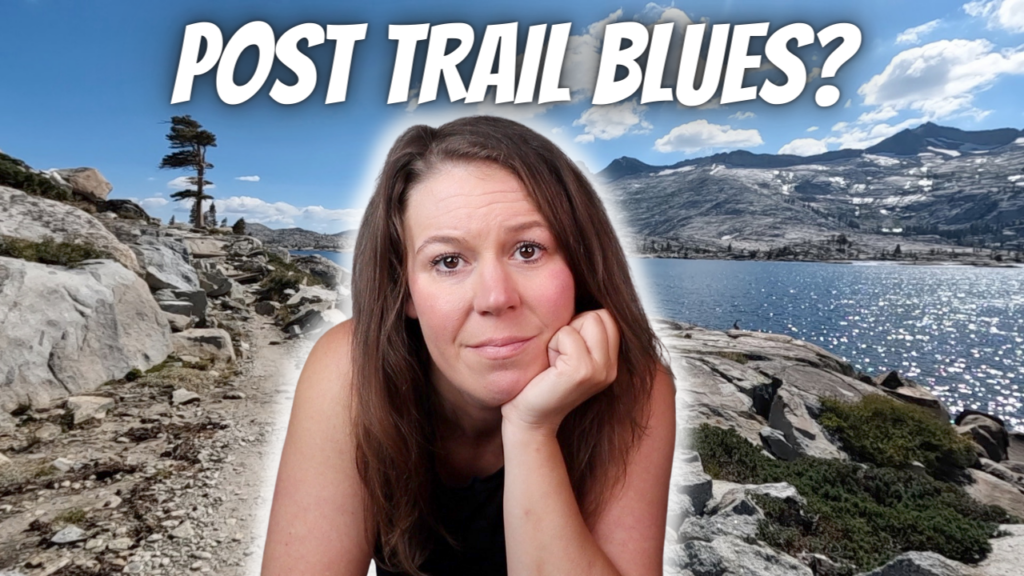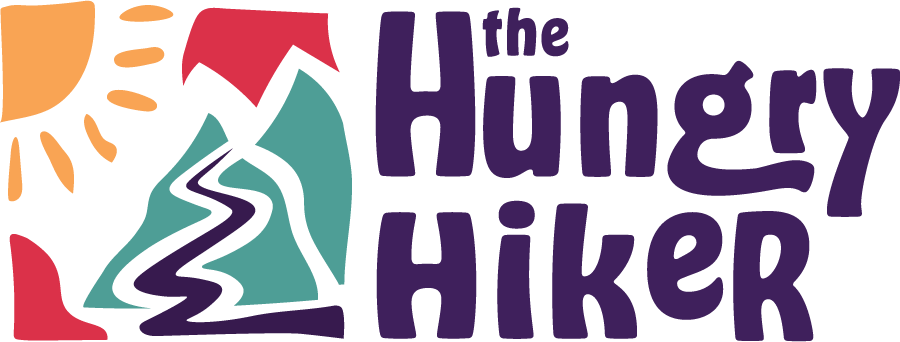
I want to talk about something most hikers don’t talk about – the Post Trail Blues.
I spent the last two months hiking 981 miles of the Pacific Crest Trail solo, starting from the Eagle Creek Trailhead near the Washington/Oregon border and headed southbound for 67 days until I reached Mammoth Lake, California.
Curious and want to follow along with my solo PCT hike this year? Check out these videos from my Pacific Crest Trail SoBo solo hike this year:
Just Getting Started | Hiking the Pacific Crest Trail SoBo
Oregon | Hiking the Pacific Crest Trail SoBo
Northern California | | Hiking the Pacific Crest Trail SoBo
Entering The Sierra | Hiking the Pacific Crest Trail SoBo
How I Got Home From the PCT | My Trail-To-Town Transition
As part of my Trail-To-Town Transition from my PCT hike this year, I made sure I had a plan in place for how I was going to deal with the Post Trail Blues before I got home since the Post Trail Blues is something I’ve struggled with after completing all of my big hikes.
Most of the time when you see a long-distance hike on social media, you see the highlight reels from all the cool things happening during the hike like big views, epic tentsites, people that are met along the way and the huge milestones hikers achieve throughout their journey.
But what happens after a big hike once a hiker goes home and returns back to “normal” life?
How does one readjust to “real” life after spending weeks and even months out on trail, hiking every single day?
The first time I ever heard about Post Trail Blues was from other hikers as I was hiking in Washington, finishing up my first PCT thru-hike back in 2018. I kept hearing about the Post Trail Blues, but I didn’t really understand what it was.
What Are The Post Trail Blues?
The Post Trail Blues are a type of mood one can experience after returning home from a long-distance hike.
A few common symptoms of the Post Trail Blues can be feelings of stress, anxiety, tiredness and nostalgia, a loss of appetite, feeling disconnected from friends and family who might not understand why you feel the way you feel after coming home, struggling to readjust back to “normal” life and in some cases, depression.
Once I got home after completing my first PCT thru-hike in 2018, the Post Trail Blues hit me HARD. I was overwhelmed with trying to figure out what was I supposed to do now?
I went from living this fun, carefree life of waking up in my tent in a new place every morning hiking all day long every day for 5+ months, being constantly wowed by Mother Nature with all of the incredible sights I got to see along the way, carrying everything I needed to survive on my back, being completely removed from most of society since I often didn’t have cell or WiFi service while I was out there and sometimes even getting surprised with trail magic from complete strangers to being overwhelmed trying to readjust back to “normal” life while struggling to figure out what I was going to do next.
Hikers planning a big trip like thru-hiking the Pacific Crest Trail spend a lot of time planning their hike, the gear they’re going to use, the clothes and shoes they’re going to wear, the food they’re going to eat and how they’re going to get to and from the trail, but not many hikers plan and prepare for what can happen mentally to them once they return back to “normal” life after their hike.
For me, experiencing the Post Trail Blues has been:
- Wanting to isolate myself from friends and family after coming home
- Being scared to drive my car on the highway
- Emotional eating the hiking snacks I loved eating while hiking the PCT
- Longing to be living out on trail again
- Feeling overwhelmed with going through all of the footage from my hike, editing videos for my YouTube Channel and even reaching out to students in my online backpacking program for women, The Confident Solo Female Backpacker System
It’s important to note here that:
Number One: Not everyone experiences Post Trail Blues, but a majority of hikers whom I know, including myself, do experience some sort of Post Trail Blues after going on a big hike for weeks or months at a time. This is why I think this topic is so important to talk about, both online here on my blog and on a public platform like YouTube.
Number Two: I’m not a licensed professional. If you’re looking for advice and need to speak to someone on how to deal with your own mental health, please seek a licensed mental health professional. In this video, I’m only speaking from my personal experience and sharing what has worked for me when dealing with the Post Trail Blues.
How I’ve Been Dealing With the Post Trail Blues
Since I’ve experienced some form of Post Trail Blues after every long-distance hike I’ve completed, I knew that I needed to have a plan in place for how I was going to deal with the Post Trail Blues, once I came back home from my hike.
Here’s how I’ve been dealing with the Post Trail Blues this time around:
Trail-To-Town Transition
I started by giving myself plenty of time for a Trail-To-Town Transition. Instead of hopping on a flight and rushing back into “normal” life, I decided to spend a couple extra days in a trail town. Then took my time getting home by riding a 35-hour scenic train ride back to Washington. An added bonus was that the train I rode back to home crossed over the PCT at one point in Dunsmuir, California, helping me to reconnect back with the trail in a small way.
Saving A Post-Hike Nest Egg
When I was planning my hike, I also made sure to plan for after my hike by saving a “Post-Hike Nest Egg”. This way, I’d have some financial cushion after my hike to help make my Trail-To-Transition less stressful and give me plenty of time to focus on my mental health instead of having to throw myself back into the swing of things right away.
Staying Active
After hiking 20+ miles each day for the last two months, I knew my body would be tired, but I also knew that it would be important to keep it moving. Since I’ve been home, I’ve been trying to practice yoga on a daily basis.
I’ve also been making it a priority to get out on trail at least once a week, revisiting some of my favorite local trails for day hikes. I’ve managed to get out for a longish day hike along the PCT here in Washington near Snoqualmie Pass. I even got to surprise a group of students from my online backpacking program for women, The Confident Solo Female Backpacker System, who had all planned a group day hike up in Mount Rainier National Park.
Focusing On Creative, Passion Projects
After my PCT thru-hike in 2018, I started my YouTube Channel, The Hungry Hiker. Creating and editing hiking and backpacking videos was a way for me to stay connected with the trail and share my passion and knowledge for solo backpacking.
It took me a couple weeks to get over the overwhelm of going through all the video footage I shot during my PCT hike this year. Once I started going through all the footage and editing videos about my PCT hike for my YouTube Channel, I got reinspired again. Editing and posting my videos was another opportunity for me to be able to share and talk about my hike. Making my hiking videos has also helped me stay connected with the trail and the trail community by answering questions viewers have about my hike and helping to inspire other hikers to want to start planning their own backpacking trips.
Purging My Belongings
Going on a long-distance hike will quickly show you that you don’t need much in order to survive out in the woods for days on end. One of my favorite things to do when I first come home from a long-distance hike is to purge my belongings. When I came home from my hike this year, I cleaned out my closet. I tried on every piece of clothing I had, went through every drawer and box and even sorted through all of my gear bins. I got rid of everything I no longer needed, wanted or didn’t fit me anymore and donated it all to Goodwill.
Reading Books
One of my goals before starting my PCT hike this year has been to read at least one book each month. Since I’ve gotten off trail this year, I’ve been making more time to read. I finished reading two books as I made my way back home from Los Angeles. Since I’ve been home here in Washington, I’ve been making it a priority to set aside time before going to bed to read a book instead of endlessly scrolling on social media.
Planning My Next Adventure
If you’ve watched any of the videos from my PCT hike this year, you’ll know that I’m already planning on picking up my PCT solo SoBo hike again next year right from where I got off this year in Mammoth Lakes and will continue heading south. I’m also in the process of putting together hikes and backpacking trips I want to go on over the next few months, not only solo, but also with students in my online backpacking program for women, The Confident Solo Female Backpacker System.
If you’re interested in joining The Confident Solo Female Backpacker System, click here to learn details about how you can schedule your free one-on-one Zoom call with me to see if this program would be a good fit for you.
Talking To A Mental Health Professional
If you’re really struggling, don’t be afraid to reach out and let someone know when you need help. Make your mental health a priority and seek out the help you need from a licensed mental health professional.
So this is how I’ve been dealing with the Post Trail Blues since getting home from hiking the PCT this year. Some days are definitely better than others, but overall, I’ve been doing alright.
The Post Trail Blues are one of the unglamourous sides of long-distance backpacking, but this is a super important hiking topic to talk about. If you’re going through something like this after coming home from a big hike, please know that you’re NOT ALONE.
If you have a hiker in your life who’s recently come back home from a big trip, take the time to check on them. Make sure they’re doing okay and let them know you’re thinking about them. Sometimes this type of experience can be really isolating.
If you’ve struggled before with some form of Post Trail Blues after coming home from a big trip, tell me down in the comments below what has helped you get through this experience.
Disclaimer: The-Hungry-Hiker.com is a participant in the Amazon Affiliate Links and Avantlinks Program, affiliate advertising programs designed to provide a means for sites to earn advertising fees by advertising and linking to Amazon.com and other affiliated sites at no cost to you. Please note, I only link to products and services I personally use and trust.
